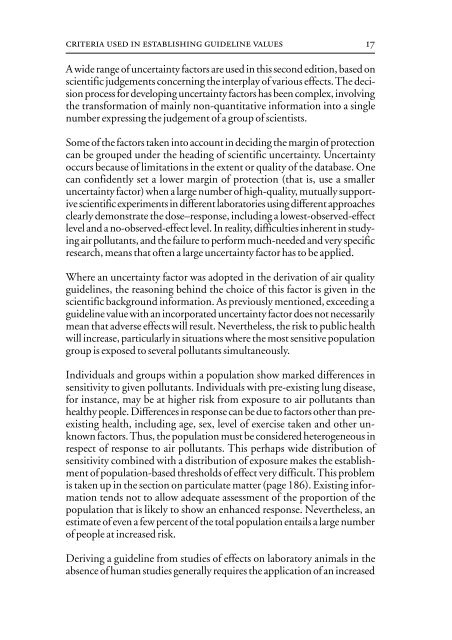Air Quality Guidelines - World Health Organization Regional Office ...
Air Quality Guidelines - World Health Organization Regional Office ...
Air Quality Guidelines - World Health Organization Regional Office ...
Create successful ePaper yourself
Turn your PDF publications into a flip-book with our unique Google optimized e-Paper software.
criteria used in establishing guideline values<br />
A wide range of uncertainty factors are used in this second edition, based on<br />
scientific judgements concerning the interplay of various effects. The decision<br />
process for developing uncertainty factors has been complex, involving<br />
the transformation of mainly non-quantitative information into a single<br />
number expressing the judgement of a group of scientists.<br />
Some of the factors taken into account in deciding the margin of protection<br />
can be grouped under the heading of scientific uncertainty. Uncertainty<br />
occurs because of limitations in the extent or quality of the database. One<br />
can confidently set a lower margin of protection (that is, use a smaller<br />
uncertainty factor) when a large number of high-quality, mutually supportive<br />
scientific experiments in different laboratories using different approaches<br />
clearly demonstrate the dose–response, including a lowest-observed-effect<br />
level and a no-observed-effect level. In reality, difficulties inherent in studying<br />
air pollutants, and the failure to perform much-needed and very specific<br />
research, means that often a large uncertainty factor has to be applied.<br />
Where an uncertainty factor was adopted in the derivation of air quality<br />
guidelines, the reasoning behind the choice of this factor is given in the<br />
scientific background information. As previously mentioned, exceeding a<br />
guideline value with an incorporated uncertainty factor does not necessarily<br />
mean that adverse effects will result. Nevertheless, the risk to public health<br />
will increase, particularly in situations where the most sensitive population<br />
group is exposed to several pollutants simultaneously.<br />
Individuals and groups within a population show marked differences in<br />
sensitivity to given pollutants. Individuals with pre-existing lung disease,<br />
for instance, may be at higher risk from exposure to air pollutants than<br />
healthy people. Differences in response can be due to factors other than preexisting<br />
health, including age, sex, level of exercise taken and other unknown<br />
factors. Thus, the population must be considered heterogeneous in<br />
respect of response to air pollutants. This perhaps wide distribution of<br />
sensitivity combined with a distribution of exposure makes the establishment<br />
of population-based thresholds of effect very difficult. This problem<br />
is taken up in the section on particulate matter (page 186). Existing information<br />
tends not to allow adequate assessment of the proportion of the<br />
population that is likely to show an enhanced response. Nevertheless, an<br />
estimate of even a few percent of the total population entails a large number<br />
of people at increased risk.<br />
Deriving a guideline from studies of effects on laboratory animals in the<br />
absence of human studies generally requires the application of an increased<br />
17

















